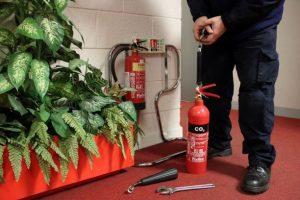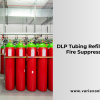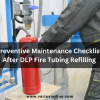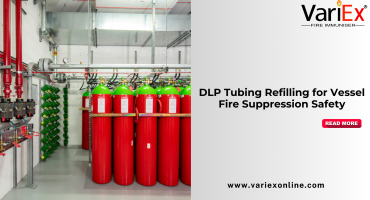![]()
Fire Immuniser
+91-7829629111
Email: info@variex.in
Varistor Technologies Pvt. Ltd.
Block-1, First Floor, Ardente Office One, Hoodi Circle, ITPL Main Road, Bengaluru, Karnataka 560048, IN
How to refill a foam fire extinguisher?
The essential guide on "How to refill a foam fire extinguisher?" Fire safety is paramount, and understanding the proper maintenance of firefighting equipment is crucial. In this comprehensive overview, we will delve into the step-by-step process of refilling a foam fire extinguisher, ensuring its optimal functionality in times of need. Whether you're a homeowner, business owner, or safety enthusiast, mastering this skill contributes to a safer environment for all. Join us as we demystify the procedure, empowering you with the knowledge to safeguard lives and property effectively.
Understanding Foam Fire Extinguishers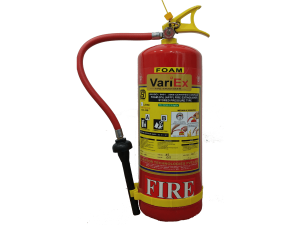
Foam fire extinguishers play a vital role in combating fires by smothering them and preventing re-ignition. Understanding the intricacies of these extinguishers is crucial for effective fire safety. In this section, we will delve into the components, working mechanism, and the types of fires for which foam extinguishers are most suitable.
Components of Foam Fire Extinguishers:
Foam fire extinguishers are typically composed of a pressurized container, a nozzle, and a solution containing water and a foaming agent. The key components include:
- Pressure Vessel: The container holds the foam solution under pressure.
- Nozzle: This component directs the discharge of the foam onto the fire.
- Foaming Agent: Usually a synthetic detergent, the foaming agent helps in the formation of a stable foam blanket over the fuel, cutting off the oxygen supply.
Working Mechanism:
Foam fire extinguishers operate based on a simple yet effective mechanism. When the extinguisher is activated, the pressurized foam solution is expelled through the nozzle. Upon contact with the air, the solution expands, creating a blanket of foam that covers the fuel surface. This blanket suppresses the release of flammable vapors and cools the surrounding area, reducing the risk of re-ignition.
Types of Fires Suitable for Foam Extinguishers:
Foam fire extinguishers are particularly effective against Class A and Class B fires, making them versatile in various settings.
- Class A Fires: These fires involve ordinary combustible materials such as wood, paper, cloth, and plastics. The foam acts as a cooling agent, extinguishing the fire by lowering the temperature.
- Class B Fires: Involving flammable liquids such as gasoline, oil, and grease, foam extinguishers create a barrier on the liquid's surface, preventing the release of flammable vapors and extinguishing the fire.
It is essential to note that foam extinguishers are not suitable for electrical fires (Class C) unless they are equipped with an additive that makes them safe for use around live electrical equipment.
Considerations for Use:
When using foam fire extinguishers, it's crucial to aim the nozzle at the base of the flames and sweep across the fire. This ensures effective coverage and maximizes the extinguishing potential of the foam.
Safety Precautions
Ensuring safety is paramount when dealing with fire-related equipment, and this holds especially true when refilling foam fire extinguishers. In this section, we will explore the necessary safety precautions to be taken before and during the refilling process.
1. Personal Protective Equipment (PPE):
Before engaging in any activities related to foam fire extinguisher refilling, it is imperative to don the appropriate personal protective equipment (PPE). This typically includes:
- Gloves: Wear chemical-resistant gloves to protect hands from any contact with foam concentrate or other chemicals.
- Safety Goggles: Shield your eyes from potential splashes or spills by wearing safety goggles.
- Protective Clothing: Consider wearing a long-sleeved shirt and pants to provide additional coverage against accidental spills.
2. Ventilation:
Ensure that the refilling area is well-ventilated. This precaution is essential to disperse any fumes or vapors that may be emitted during the refilling process. Adequate ventilation helps maintain a safe breathing environment and minimizes the risk of exposure to potentially harmful substances.
3. Controlled Workspace:
Establish a controlled workspace for the refilling process. Keep the area organized, clean, and free from clutter to avoid accidents. Ensure that there are no open flames, sparks, or smoking in the vicinity, as foam concentrates may be flammable.
4. Emergency Equipment:
Have emergency equipment readily available. This includes a first aid kit, a fire extinguisher suitable for the type of fire risk in the area, and an emergency eyewash station. Being prepared for unforeseen circumstances enhances the overall safety of the refilling process.
5. Training and Familiarity:
Only individuals who are trained and familiar with the specific procedures of foam fire extinguisher refilling should undertake this task. Training ensures that personnel are aware of potential hazards, know how to handle emergencies, and can perform the refilling process accurately.
6. Follow Manufacturer Guidelines:
Always adhere to the manufacturer's guidelines and recommendations for the foam fire extinguisher being refilled. This includes using the correct type and amount of foam concentrate, as well as following any specific instructions provided by the manufacturer.
7. No Smoking:
Prohibit smoking in the refilling area. Foam concentrates can be flammable, and smoking poses a significant fire hazard. Implement a strict no-smoking policy in and around the refilling workspace.
Step-by-Step Refilling Process
Step 1: Gather Necessary Materials
Ensure you have all the required materials for the refilling process. This typically includes a foam concentrate suitable for your extinguisher, a funnel, a graduated cylinder for accurate measurement, and personal protective equipment (PPE) such as gloves and safety goggles.
Step 2: Emptying the Extinguisher
Before refilling, make sure the fire extinguisher is depressurized. Discharge any remaining foam by pointing the nozzle away from you and activating the extinguisher until it's completely empty. This step is crucial for safety and to prevent mixing different types of foam concentrates.
Step 3: Mixing and Adding Foam Concentrate
Follow the manufacturer's guidelines to mix the foam concentrate with the appropriate amount of water. Use the graduated cylinder for precise measurements. Once mixed, use a funnel to pour the foam concentrate into the extinguisher. Take care not to spill, and ensure that the concentrate is added evenly.
Step 4: Pressurizing the Extinguisher
After adding the foam concentrate, pressurize the extinguisher. Use a compatible pressurizing gas, following the manufacturer's specifications. Attach the pressurizing device to the extinguisher and slowly introduce the gas until the desired pressure is reached. Check the pressure gauge to ensure it falls within the recommended range.
Step 5: Checking for Leakage and Pressure
Conduct a visual inspection of the extinguisher to ensure there are no signs of leakage. Check all connections and valves. Use a pressure gauge to verify that the extinguisher maintains the correct pressure. If there are any leaks or pressure irregularities, address them before putting the extinguisher back into service.
Step 6: Testing the Refilled Extinguisher
Test the refilled extinguisher in a controlled environment. Aim the nozzle away from people and flammable materials, and discharge a short burst to ensure the foam is expelled correctly. Verify that the foam covers the intended area effectively. This step confirms that the extinguisher is operational and ready for use in case of a fire.
Step 7: Record-Keeping
Maintain a detailed record of the refilling process, including the date of refilling, the type and amount of foam concentrate used, and any observations or actions taken. Proper record-keeping helps track the extinguisher's maintenance history and ensures compliance with safety regulations.
Checking for Leakage and Pressure
Before putting a foam fire extinguisher back into service, it's crucial to conduct a thorough examination for signs of leakage and ensure the pressure within the extinguisher is at the optimal level. This step ensures the extinguisher's reliability when needed most.
Begin by visually inspecting the entire extinguisher. Look for any visible signs of leakage, such as dampness or residue around seams, valves, or the nozzle. Any indication of leakage could compromise the extinguisher's effectiveness and should be addressed promptly.
Next, verify the pressure within the extinguisher. Pressure levels are a critical factor in the proper functioning of the device. Most extinguishers are equipped with a pressure gauge, which should fall within the range specified by the manufacturer. If the pressure is too high or too low, it can affect the foam's discharge and the extinguisher's overall performance.
In cases where the extinguisher exhibits signs of leakage or the pressure is outside the recommended range, immediate action is necessary. Address any leaks by tightening connections or replacing faulty components. Adjust the pressure using the appropriate pressurizing gas, following the manufacturer's guidelines.
Troubleshooting Common Issues
Leaks - A Damp Dilemma: Ever notice your extinguisher feels a bit wet? That's a sign of a leak. No worries, though! It's often just a loose connection. Check the nozzle, valves, and seams. If something seems loose, tighten it up. Think of it like fixing a leaky faucet at home – a simple twist, and you're good to go.
Pressure Problems - Finding the Sweet Spot: Your extinguisher has a sweet spot for pressure. Too high or too low, and it won't work right. Luckily, most extinguishers have a gauge. If the needle is out of the sweet spot, you need a little adjustment. It's like tuning a guitar. Add or release pressure using the right gas. Follow the instructions – it's like hitting the right note for your extinguisher to perform its best.
Foam Fumbles - Not Enough Fluff: Is your foam not as fluffy as it should be? Think of it like making a cake – the right ingredients matter. Check the mix. Measure your foam concentrate accurately, mix it well with water, and make sure it's the right type. It's like ensuring you have the right recipe for your extinguisher to whip up the perfect foam.
Maintenance Tips for Your Foam Fire Extinguisher
Maintaining your foam fire extinguisher is a bit like taking care of a trusty tool in your toolkit – it needs some attention to make sure it's always ready for action.
Regular Check-ups: Think of your extinguisher like your car. Just as you'd check the oil and tires, give your extinguisher a visual once-over. Look for any obvious signs of wear or damage. If anything seems off, it might need a bit of fixing.
Keep it Clean: Dust and grime can settle on your extinguisher, just like on your bookshelf. Wipe it down occasionally to keep it clean. A clean extinguisher is more reliable, and you can spot any issues more easily.
Check the Pressure: Your extinguisher has a sweet spot for pressure, just like your bike tires. There's usually a gauge – make sure the needle is in the green zone. If it's not, adjust the pressure using the right gas. It's like keeping your tires pumped for a smooth ride.
Watch for Leaks: If your extinguisher is sweating or leaving damp spots, it might have a leak. Tighten any loose connections, like you would with a leaky faucet. A snug fit goes a long way in keeping things in order.
Label Love: The label on your extinguisher is like its user manual. Take a moment to read it – it has essential information. Know the type of fires your extinguisher can handle and the correct way to use it. It's like understanding the instructions for your favorite gadget.
Professional Check-ups: Just as you'd take your car to the mechanic, have a professional look at your extinguisher regularly. They can catch any hidden issues and give it a thorough check-up. It's like an annual health check for your safety tool.
In a nutshell, taking care of your foam fire extinguisher is a bit like looking after a helpful tool in your home. Regular check-ups, keeping it clean, and ensuring the pressure is just right are simple tasks, much like maintaining your car or bike. If you notice any leaks, it's akin to fixing a leaky faucet – a quick adjustment can make a big difference. And don't forget to give the label a read – it's like the user manual for your safety tool, helping you understand how it works best. Just as you'd take your car to the mechanic, having a professional check your extinguisher ensures it's in top-notch condition. Think of your extinguisher as a reliable friend; treat it well, and it'll be there for you in case of any unexpected fires. So, keep an eye on it, give it a little care, and enjoy the peace of mind that comes with having a dependable safety companion in your home or workplace.
Frequently Asked Questions
1. Why is it necessary to refill a foam fire extinguisher?
Refilling a foam fire extinguisher is crucial to ensure it remains fully charged and ready for action. Over time, the pressure may decrease, and the foam concentrate may deplete, diminishing the extinguisher's effectiveness.
2. Can I refill a foam fire extinguisher on my own?
Refilling a foam fire extinguisher involves handling pressurized containers and specific chemicals, making it a task best left to professionals. Technicians have the expertise and equipment to perform the refill safely and accurately.
3. How frequently should I refill my foam fire extinguisher?
The frequency of refilling depends on factors such as usage, environmental conditions, and manufacturer recommendations. Regular inspections should guide the decision to refill, often as part of routine maintenance.
4. What should I do if I notice a leak after refilling?
If there's any sign of leakage post-refill, it's crucial to address it immediately. Tighten loose connections, and if the issue persists, seek professional assistance to avoid compromising the extinguisher's effectiveness.
5. Can I use any foam concentrate for refilling?
Using the foam concentrate specified by the extinguisher's manufacturer is crucial. Using the wrong type or concentration can impact performance and even pose risks.
Final Say
We at VariEx.in or Variexonline.com have mastered the art of designing, installing, inspecting, and fixing automatic sprinkler systems with the help of our in-house team, which is capable of delivering the fire sprinkler services you need, whether large or small and at affordable cost.
To schedule a fire sprinkler installation, or you think our services could benefit your commercial property, contact us online or give us a call at, 7829629111
"WHAT YOU CAN READ NEXT"
 Read more +24 November 2023 in Fire Extinguisher
Read more +24 November 2023 in Fire ExtinguisherWhat types of fire extinguishers are available for different fire classes?
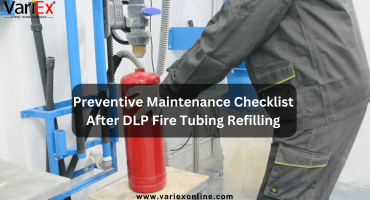 Read more +11 July 2025 in Fire Suppression
Read more +11 July 2025 in Fire Suppression

